Sentencing commissions vary greatly in their purpose and structure. This article will examine the composition of sentence commissions and how members are selected. This is an introductory overview for the 23 jurisdictions on which data is available.1 Some sections of this report will compare commissions with and without a mandate to develop sentencing guidelines to see how their composition differs.2
How Many Members are on Each Commission?
An average sentencing commission has around 17 members, but the number varies significantly across jurisdictions. Oregon and the federal government have the smallest commissions at 7 members, Ohio has the largest at 31. Some of the larger commissions are those that have broader mandates to develop and implement sentencing policy, but not to develop sentencing guidelines (e.g., Missouri, Louisiana, Connecticut, Illinois, and New Mexico). See The Role of Sentencing Commissions to learn more. The average number of commission members is around 20 in these states. Note that some commissions have non-voting members that act in an advisory role; these members are often ex-officio.3
Chart 1. The Size of Sentencing Commissions
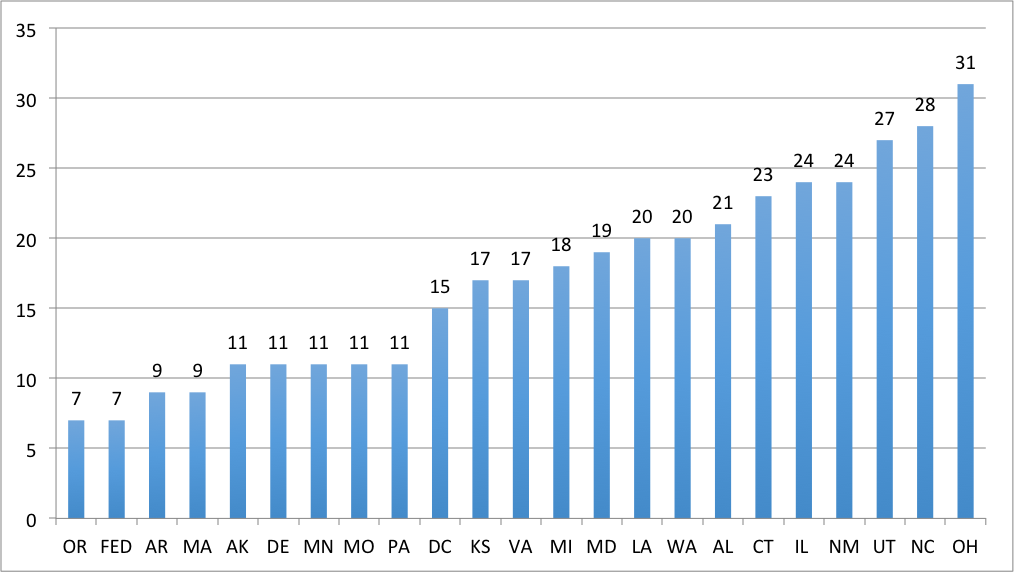
Who Sits on Sentencing Commissions?
Chart 2. Typical Commission Members
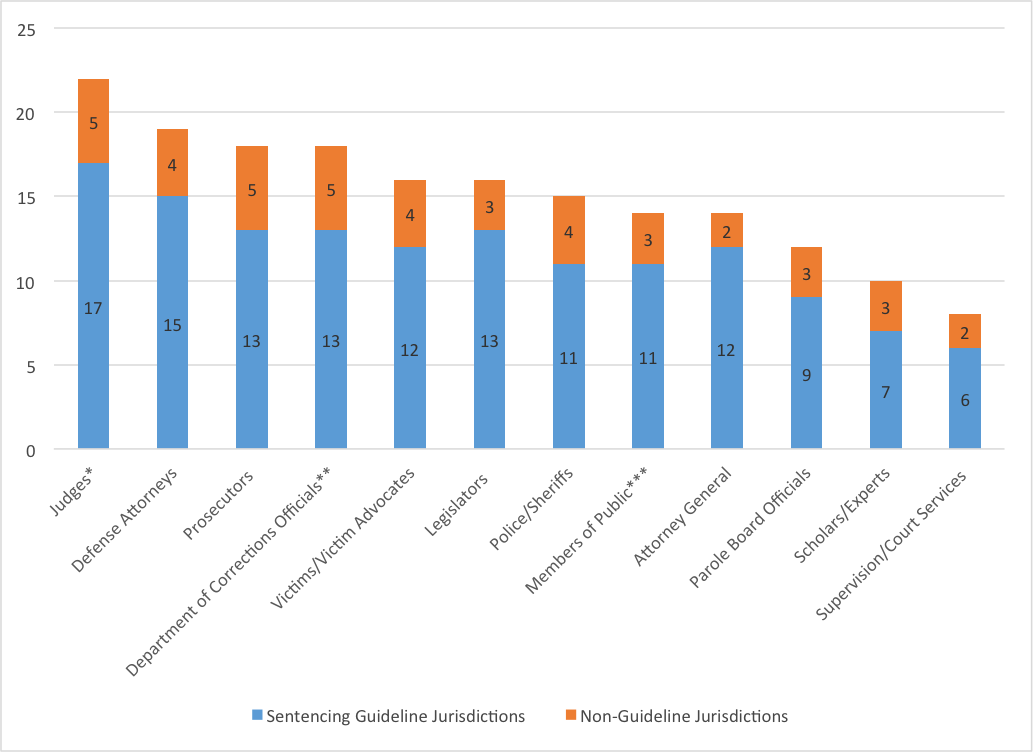
*In addition to other judges, Chief Justices may sit on sentencing commissions in Alaska, Alabama, and Kansas. However, in each of these jurisdictions, they are also free to appoint a designee to serve in their place. In Ohio, as discussed below, the Chief Justice serves ex-officio as the chairperson of the commission.
**This is often the head of the Department of Corrections (or an equivalent body) appointed ex-officio.
***Members of the public are individuals with no other specific qualifications to serve.
Designees
Note that in most jurisdictions, ex-officio members of a commission may appoint a designee to serve in their place. Thus, for example, Alabama’s chief justice and governor have never served on that state’s commission.4
Judges and Attorneys
Judges sit on nearly every commission, which is probably to be expected because sentencing has traditionally been a judicial function. Most commissions contain both prosecutors and criminal defense attorneys, and some states also appoint attorneys outside of the criminal law field.5 A handful of states include judges, attorneys, and officials who have expertise in juvenile justice.6
Elected Officials
The current Governor or their designee may sit on the commission in Alabama and Illinois. The legislative branch is also represented on many commissions, sometimes along with statutory language that attempts to reduce political partisanship.7
Criminal Justice Authorities
Local and state law enforcement personnel8 and department of corrections officials9 are heavily represented on sentencing commissions. Others involved in the criminal justice system include public safety officials,10 community supervision professionals,11 and parole board members.12
Experts
Some states allow various types of criminal justice specialists to play a role in sentencing; these may include mental or behavioral health professionals,13 criminologists and other academics,14 policy experts,15 and/or other experts with unique perspectives on the justice system.16
Other Participants
The voices of crime victims and their advocates have been particularly well incorporated into most commissions (but only North Carolina’s commission includes a former prison inmate).17 Representatives of county18 and local governments19 and communities20 play a role in some commissions. Finally, members of the public with no specific qualifications to serve are often also part of sentencing commissions.21
How are Sentencing Commission Members Selected?
The selection process for appointed commission members varies greatly from jurisdiction to jurisdiction.22 In some states, one official has the power to appoint all members; other states have much more complex arrangements. For example, Connecticut has 23 commission members, some of whom are selected by the Governor, Chief Justice, President Pro Tempore of the Senate, Speaker of the House, Senate and House Minority Leaders, and Senate and House Minority Leaders.
Chart 3. Which Officials Have Appointment Powers in Their Jurisdiction?
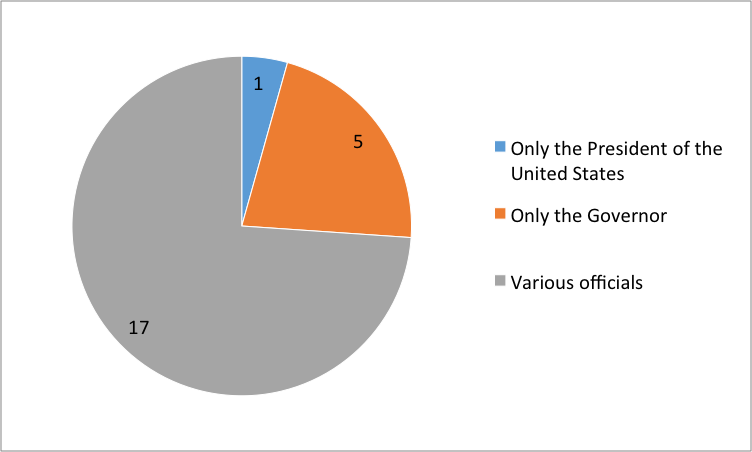
The Governor has a role in selecting some commission members in 18 out of 23 (78.3%) of the sentencing commission jurisdictions; however, in most states other officials also participate. In 5 jurisdictions, the Governor is the only person who selects all appointed members of a commission.23
Chief Justices also play an important part in selecting some commission members in 14 out of 23 (60.9%) of the sentencing commission jurisdictions. The Speaker of the House and President Pro Tempore of the Senate have the power to select some commission members in over half of the sentencing commission states. In Ohio, Kansas, and Connecticut legislative minority leaders also have some selection power. Some states utilize individuals with special expertise to choose specific members of commissions; for example, Alaska’s Native Justice Center selects an Alaskan Native member, and the New Mexico District Attorneys’ Association selects a prosecutor.
Who is the Commission Chairperson, and How is that Person Selected?
Chart 4. Qualifications for Commission Chairperson
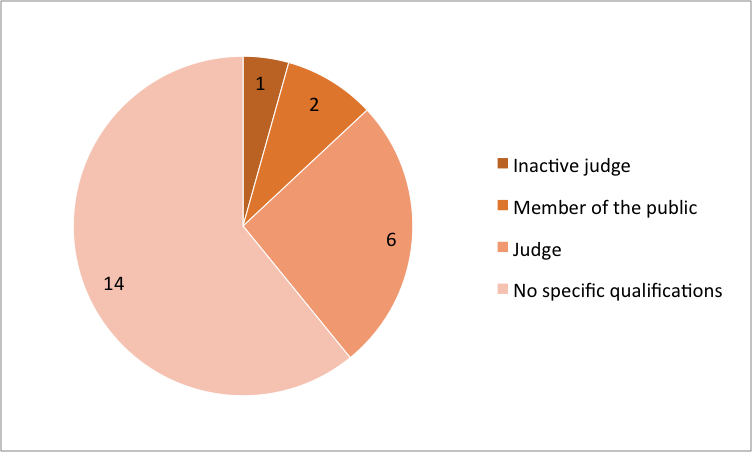
The chairperson plays a leadership role in each commission. In a majority of sentencing commissions, there are no specific qualifications for who is selected as chair. In seven commissions the chairperson must be either an active or inactive judge. Two jurisdictions, Michigan and New Mexico, require a member of the public to serve as the chairperson.
The chairperson is selected in a variety of ways. In exactly half of the jurisdictions, the Governor appoints a specific chairperson or selects that chairperson from among the members. In five jurisdictions, the chairperson is appointed by the Chief Justice (in all five, these chairs are judges).24 In Ohio, the Chief Justice serves as the chairperson by virtue of office. In Alabama, the Chief Justice may serve as chairperson but may also choose to appoint another judge and has consistently done so. In four other jurisdictions, the commission is selected and then votes for its own leader.25 Finally, in Utah, by custom the Governor recommends a chairperson whom the commission then appoints, though the Commission is not required by statute to follow any part of this procedure.26
Chart 5. Selection of Head of Commission
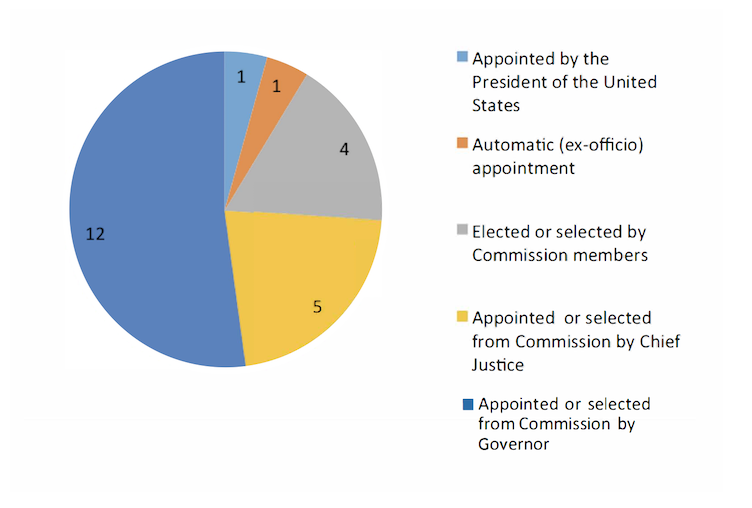
Sources
Ala. Code § 12-25-3 (2016).
Alaska Stat. § 44.19.642 (2016).
Ark. Code Ann. § 16-90-802 (2016).
Conn. Gen. Stat. § 54-300 (2016).
Del. Code Ann. tit. 11, § 6580 (2016).
D.C. Code § 3-102 (2016).
730 Ill. Comp. Stat. 5/5-8-8 (2016).
Kan. Stat. Ann. § 74-9102 (2016).
La. Stat. Ann. § 15:323 (2016).
Md. Code Ann. Crim. Proc. § 6-204 (West 2016).
Mass. Gen. Laws ch. 211E, § 1 (2016).
Mich. Comp. Laws § 769.32a (2016).
Minn. Stat. § 244.09 (2016).
Mo. Rev. Stat. § 558.019 (2016).
N.M. Stat. Ann. § 9-3-10 (2016).
N.C. Gen. Stat. § 164-37 (2016).
Ohio Rev. Code Ann. § 181.21 (West 2016).
Or. Rev. Stat. § 654 (2016).
42 Pa. Cons. Stat. § 2152 (2016).
Utah Code Ann. § 63M-7-401 (West 2016).
Va. Code Ann. 71.1-802(2016).
Wash. Rev. Code § 994A.860 (2016).
28 U.S.C. § 991 (2016).
- 1These are AK, AL, AR, CT, DE, IL, KS, LA, MA, MD, MI, MN, MO, NC, NM, OH, OR, PA, UT, VA, WA, Washington D.C., and the Federal Sentencing Commission. New York’s Permanent Commission on Sentencing, which does not have any statutory law governing its membership, is excluded from the data.
- 2States that have sentencing commissions but no current mandate to develop sentencing guidelines include CT, IL, LA, MO, and NM. New York, which is not included in this report, is also in that group. There are also two states, FL and TN, that have guidelines in force but that no longer have a sentencing commission.
- 3These jurisdictions include the federal government, Alaska, Arkansas, DC, Massachusetts, Oregon, Pennsylvania, and Washington.
- 4Ala. Sentencing Comm’n, Alabama Sentencing Commission Reports (2002-2016 available), http://sentencingcommission.alacourt.gov/publications.html.
- 5D.C. seats an attorney who does not specialize in criminal law; North Carolina and Ohio include general members of their respective state bar associations. Missouri includes one private member of the bar. Kansas and Ohio require that attorneys represent multiple political parties. New Mexico requires the participation of one attorney who is Native American.
- 6Louisiana, New Mexico, Ohio, Utah, and Washington have done this; in all but the first of these states, commissions are currently involved in establishing juvenile sentencing guidelines/policies.
- 7Illinois, Michigan, Ohio, Pennsylvania, and Utah require legislative participation from multiple political parties. On four commissions, including Alaska, D.C., Oregon, and Washington legislators are non-voting participants.
- 8For example, eight jurisdictions require a local police officer or chief to sit on a commission. Nine jurisdictions require a sheriff (i.e. county-level law enforcement) to sit on a commission. Illinois requires the Director of State Police to be a commission member, while Ohio seats the Superintendent of the State Highway Patrol.
- 9The head of the Department of Corrections is on the commission in most states. In D.C., Louisiana, Massachusetts, and Pennsylvania, s/he is a non-voting member.
- 10The Connecticut commission includes the Commissioner of Emergency Services and Public Protection; the Alaska, Massachusetts, North Carolina, and New Mexico commissions include the Commissioner (or Secretary) of Public Safety.
- 11Utah includes juvenile and adult rehabilitation professionals; Minnesota includes a probation or parole officer. Massachusetts includes the Commissioner of Probation as a non-voting member, while Kansas includes the director of a community corrections program. D.C. and Kansas include court services officials.
- 12Paroling authorities are involved in half of all sentencing commissions; most often the chairperson of the parole board sits on the commission ex-officio.
- 13Michigan’s Commission includes a mental or behavioral health professional; Alaska and Connecticut seat a representative from the state mental health agency.
- 14For example, Alabama, Illinois, Louisiana, and North Carolina involve an academic with a background in justice or corrections; Pennsylvania seats either a law professor or a criminologist.
- 15For example, North Carolina seats a member of the Justice Policy Task Force; D.C. seats a professional from a sentencing research organization; Maryland seats a “recognized expert in criminal justice or corrections policy.”
- 16Michigan requires an advocate of alternatives to incarceration as well as a representative from the Coalition to End Domestic and Sexual Violence. New Mexico includes both the Secretary of Public Education and the Secretary of Children, Youth, and Families on the commission.
- 17In Connecticut and Pennsylvania, this is an ex-officio position held by the official Victim’s Advocate. In Massachusetts and Pennsylvania, the victims’ representative is a non-voting member.
- 18In Alabama, Ohio, and Michigan, a County Commissioner must serve; in Washington, an elected county official must serve.
- 19In Ohio, a City Manager, Mayor, or Municipal Corp. Board Member must serve. In Washington, an elected city official must serve.
- 20In Illinois, a representative of a community-based organization must serve; in Louisiana and North Carolina, the Commission includes members of the business community. Kansas specifically requires one commission member from a “racial minority group;” Alaska selects one member from the Alaskan Native community.
- 21In Kansas, Oregon, and on the Federal Sentencing Commission, members of the public must be from various political parties.
- 22Many commission members serve ex-officio; in other words, they are part of the commission by virtue of already holding a certain office (i.e. the Head of the Department of Corrections). The rest of the members must be chosen to serve.
- 23These states are Arkansas, Massachusetts, Michigan, Oregon, and Washington.
- 24These are Connecticut, Delaware, and North Carolina (in which active judges chair), Virginia (in which an inactive judge chairs), and Alabama, in which the Chief Justice may either serve as chair or appoint an active or retired judge.
- 25These are Alaska, D.C., Illinois, and Pennsylvania.
- 26Email from Jennifer Valencia, Executive Director of the Utah Sentencing Commission, to author (July 14, 2016) (on file with author).

